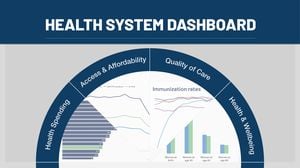President Donald Trump has officially reinvigorated his administration's trade policies, strategically implementing tariffs on imports from major trading partners Mexico, Canada, and China. Scheduled to take effect on February 1, 2025, these tariffs—25 percent on goods from Mexico and Canada and 10 percent on Chinese imports—are not simply economic maneuvers; they also serve as tools for advancing Trump's domestic and foreign policy goals.
Shortly after re-entering the Oval Office, the president signed orders directing federal agencies to investigate unfair trade practices, singling out China for scrutiny. Specifically, Trump aims to evaluate China's compliance with the previously negotiated phase one trade deal from 2020 and to identify ways through which the country has circumvented tariffs.
According to William Lee, chief economist at the Milken Institute, Trump's tariff strategy has evolved since his first term. "Trump is using tariffs differently in his second term as 'a policy tool for not just economic policy, but also for foreign policy and national security,'" Lee noted. This shift is indicative of Trump’s broader strategy, which now includes using tariffs as leverage not only to rectify trade imbalances but also to address immigration fallout, compelling foreign countries to accept deportees and curb drug flows. For Trump, tariffs have become synonymous with his “Make America Great Again” agenda.
During the late January discussions at the World Economic Forum, Trump reiterated the necessity of tariffs, stating, "If you don’t make your product in America, you will have to pay a tariff." This indicates not just an economic position but also reinforces the perspective of protecting American manufacturing jobs, promoting domestic production, and limiting dependency on foreign entities.
Despite the powerful rhetoric surrounding tariffs, the revenue generated from them has been minimal—accounting for less than 2 percent of total U.S. government revenue last year. Nevertheless, experts convey their true utility lies beyond mere revenue generation. Tariffs affect foreign companies' access to one of the most lucrative markets globally, the U.S., which is expected to grow by 2.7 percent this year compared to just 1 percent for the European Union, according to the International Monetary Fund.
Trump's administration sees the U.S. economy as resilient and capable of sustaining its growth even amid tariff impositions. Economists like Yeh Yao-Yuan predict these tariffs may encourage global supply chains to disengage from China, thereby undermining Beijing's influence on the world stage. "Tariffs could propel global supply chains to move away from China," said Yeh, highlighting how reliance on Chinese manufacturing could soon be reconsidered by various industries.
Interestingly, many observers reflect on Beijing's economic vulnerabilities. Previously, China thrived under the shadow of uninterrupted growth, yet as its economy stumbles and increasingly relies on exports, it finds itself more susceptible to tariff strategies employed by the U.S. Trump remarked during a Fox News interview about the immense leverage tariffs grant the U.S. over China: "We have one very big power over China, and that's tariffs, and they don't want them." This sentiment appears to amplify his perceived strength on the trade front as his administration argues for continued leverage over China.
The challenges facing China are more pronounced amid its rigid adherence to an export-driven economy, as observed by international business experts. Li Shaomin, professor at Old Dominion University, elaborated on how China's economic system, which operates much like a colossal corporate enterprise, relies heavily on global trade. If Western economies begin to sever their ties with China, the repercussions would strike at the heart of its economic model, leading to severe consequences for the Chinese populace.
The dynamic nature of these tariffs is evident as Trump applies policies by threatening new tariffs—notably, the potential imposition of 10 percent universal tariffs on Chinese goods soon if talks fail to produce satisfactory results. Economic analysts predict such tariffs could be enacted, reiteratively pointing to the likelihood of discontent within the American consumer sector if prices rise. A study by the U.S. International Trade Commission noted the minimal impact of Trump's initial Section 301 tariffs from 2018 to 2021. It found price increases of just 0.2 percent on affected domestic products, easing concerns over the drastic consequences of higher tariffs.
Yet the rift between Washington and Beijing remains stark, with each side expressing reluctance to bridge the divide on core issues such as technology transfer and fentanyl regulation. Trump’s overtures toward supply chain independence only intensify these tensions, leading analysts like Yeh to assert, "I don’t see a solution for Trump…unless Beijing concedes." Trump's pivot to tariffs reflects his discontent with previous trade negotiations and his insistence on substantial concessions from overseas partners—an expectation unlikely to materialize.
With international trade relations growing increasingly complex, Trump's reassertion of tariffs as his marquee issue not only targets economic gains but also approaches foreign policy through the lens of trade, pressing nations to reconsider their commitments and influence. Undoubtedly, the impact of these policies will ripple through markets, prompting stakeholders to reconsider strategy as they adapt to the shift back toward protectionism represented by the current administration.



